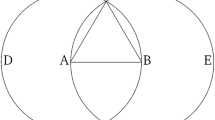Abstract
The main thesis of the present paper is that geometry deals with mental entities (the so-called geometrical figures) which possess simultaneously conceptual and figural characters. A geometrical sphere, for instance, is an abstract ideal, formally determinable entity, like every genuine concept. At the same time, it possesses figural properties, first of all a certain shape. The ideality, the absolute perfection of a geometrical sphere cannot be found in reality. In this symbiosis between concept and figure, as it is revealed in geometrical entities, it is the image component which stimulates new directions of thought, but there are the logical, conceptual constraints which control the formal rigour of the process. We have called the geometrical figuresfigural concepts because of their double nature. The paper analyzes the internal tensions which may appear in figural concepts because of this double nature, development aspects and didactical implications.
Similar content being viewed by others
References
Anderson, J. R.: 1978, ‘Arguments concerning representations for mental imagery’,Psychological Review, 249–277.
Anderson, J. R.: 1990,Cognitive Psychology and Its Implications, Carnegie-Mellon University, Third Edition, W. H. Freeman and Co., New York.
Anderson, J. R. and Bower, G. H.: 1973,Human Associative Memory, Hemisphere Press, Washington DC.
Blanc-Garin, J.: 1974, ‘Recherches recentes sur les images mentales: Leur rôle dans les processus de traitment perceptif et cognitif’,Année Psychologique 74, 533–564.
Denis, M. and Dubois, D.: 1976, ‘La représentation cognitive’,Année Psychologique 76, 541–562.
Fischbein, E.: 1963,Conceptele Figurale (in Rumanian), Editura Academiei RPR, Bucuresti.
Fischbein, E. and Kedem, I.: 1982, ‘Proof and certitude in the development of mathematical thinking’, in A. Vermandel (ed.),Proceedings of the Sixth International Conference for the Psychology of Mathematical Education, Universitaire Instelling, Antwerpen.
Kline, M.: 1980,Mathematics. The Loss of Certainty, Oxford University Press, New York.
Kosslyn, S. M.: 1980,Image and Mind, Harvard University Press, Cambridge, MA.
Kosslyn, S. M.: 1983,Ghosts in the Mind's Machine. Creating and Using Images in the Brain, W. W. Norton & Company, New York.
Mariotti, A.: 1992, ‘Imagini e concetti in geometria’,L'Insegnamento Della Matematica e Delle Scienze Integrata 15(9), 863–885.
Paivio, A.: 1970, ‘On the functional significance of imagery’,Psychological Bulletin 73(6), 385–392.
Paivio, A.: 1971,Imagery and Verbal Processes, Holt, Rinehart and Winston, New York.
Panzycz, B.: 1988, ‘“Knowing” vs. “Seeing”. Problems of the plane representation of space geometry figures’,Educational Studies in Mathematics 19, 79–92.
Piaget, J. and Inhelder, B.: 1966,LImage Mentale Chez l'Enfant. Etude sur le Développement des Représentations Imagées, PUF, Paris.
Pylyshyn, Z. W.: 1973, ‘What the mind's eye tells the mind's brain: A critique of mental imagery’,Psychological Bulletin 80, 1–24.
Piéron, H.: 1957,Vocabulaire de la Psychologie, PUF, Paris.
Rohwer, W. D., Jr.: 1970, ‘Images and pictures in children's learning’,Psychological Bulletin 73(6), 393–403.
Shepard, R. N.: 1978, ‘Externalization of mental images and the act of creation’, in B. S. Randhawa and W. E. Coffman (eds.),Visual Learning, Thinking and Communication, Academic Press, New York, pp. 133–189.
Shepard, R. N. and Cooper, L. A.: 1982,Mental Images and Their Transformations, MIT Press, Cambridge, MA.
Tall, D.: 1991, ‘The psychology of advanced mathematical thinking’, in D. Tall (ed.),Advanced Mathematical Thinking, Kluwer Academic Publishers, Dordrecht, pp. 4–21.
Author information
Authors and Affiliations
Rights and permissions
About this article
Cite this article
Fischbein, E. The theory of figural concepts. Educ Stud Math 24, 139–162 (1993). https://doi.org/10.1007/BF01273689
Issue Date:
DOI: https://doi.org/10.1007/BF01273689




